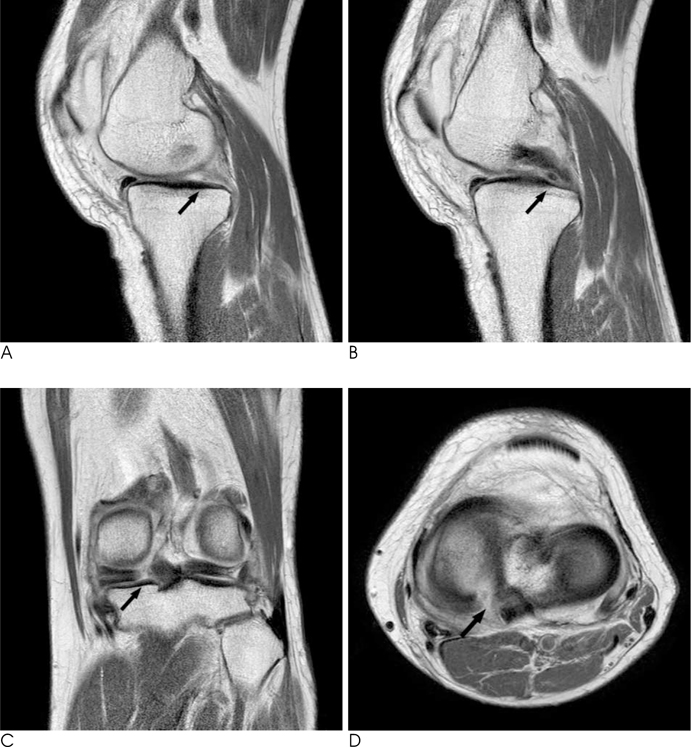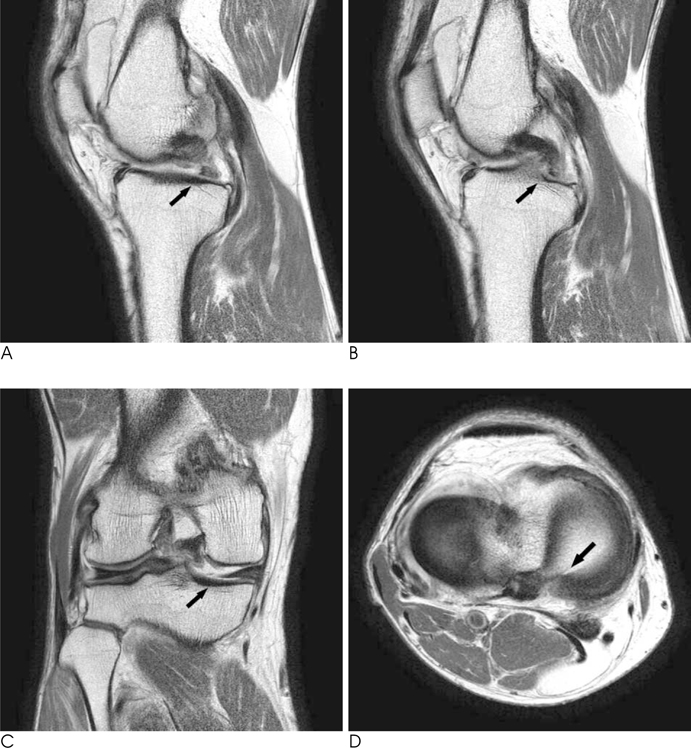J Korean Soc Radiol.
2010 Nov;63(5):475-481. 10.3348/jksr.2010.63.5.475.
MR Imaging of a Posterior Root Tear of the Medial Meniscus: Diagnostic Accuracy of Various Tear Configurations and Associated Knee Abnormalities
- Affiliations
-
- 1Department of Diagnostic Radiology, Inje University, Seoul Paik Hospital, Korea. jcshim96@unitel.co.kr
- 2Department of Orthopedic Surgery, Inje University, Seoul Paik Hospital, Korea.
- KMID: 2097921
- DOI: http://doi.org/10.3348/jksr.2010.63.5.475
Abstract
- PURPOSE
To evaluate the diagnostic accuracy of the various tear configurations in a medial meniscal posterior horn root tear and assess whether any correlation exists with other associated knee abnormalities in MR imaging.
MATERIALS AND METHODS
A retrospective review of 146 preoperative knee MR images were performed by one experienced musculoskeletal radiologist. The tear configuration and other abnormalities were evaluated. Sensitivity, specificity, and diagnostic accuracy of each configuration in the medial meniscal posterior horn root tear were calculated.
RESULTS
A total of 48 medial meniscal posterior horn root tears including 38 full-thickness radial, 7 partial-thickness radial, and 3 complex tears were confirmed during arthroscopy. Overall, the sensitivity, specificity, and accuracy for the detection of medial meniscal posterior horn root tear were 92% (44/48), 99% (97/98), and 97%(141/146), respectively. For each tear configuration, sensitivity, specificity, and accuracy were 82% (31/38), 97% (105/108), and 93% (136/146) for full-thickness radial tears, respectively, and 43% (3/7), 94% (131/139), and 91% (134/146) for partial-thickness radial tears, respectively. The incidence of degenerative joint disease was 85% (41/48) for the tear group, revealing a strong association. In patients with a root tear and with degenerative joint disease, the incidence of high grade cartilage defects involving the medial femoral condyle was at 80% (33/41), compared to 56% (23/41) for the presence of medial meniscal extrusion. In contrast, a similar comparison of incidence for patients with no root tears but with degenerative joint disease was at 68% (17/25) and 26%(8/31), respectively.
CONCLUSION
MR imaging is very sensitive for the detection of medial meniscal root tears, but has reduced the accuracy with regard to each tear configuration. Medial meniscal root tears showed a strong association with degenerative joint disease. High grade cartilage defects of the medial femoral condyle and medial meniscal extrusions also reveal a strong association with medial meniscal root tears.
MeSH Terms
Figure
Reference
-
1. Jones AO, Houang MT, Low RS, Wood DG. Medial meniscus posterior root attachment injury and degeneration: MRI findings. Australas Radiol. 2006; 50:306–313.2. Ramnath RR, Magee T, Wasudev N, Murrah R. Accuracy of 3-T MRI using Fast Spin-Echo technique to detect meniscal tears of the knee. AJR Am J Roentgenol. 2006; 187:221–225.3. Jee WH, McCauley TR, Kim JM, Jun DJ, Lee YJ, Choi BG, et al. Meniscal tear configurations: categorization with MR Imaging. AJR Am J Roentgenol. 2003; 180:93–97.4. Matava MJ, Eck K, Totty W, Wright RW, Shively RA. Magnetic resonance imaging as a tool to predict meniscal reparability. Am J Sports Med. 1999; 27:436–443.5. Lee YG, Shim JC, Choi YS, Kim JG, Lee GJ, Kim HK. Magnetic resonance imaging findings of surgically proven medial meniscus root tear: tear configuration and associated knee abnormalities. J Comput Assist Tomogr. 2008; 32:452–457.6. Lee SY, Jee WH, Kim JM. Radial tear of the medial meniscal root: reliability and accuracy of MRI for diagnosis. AJR Am J Roentgenol. 2008; 191:81–85.7. Tuckman GA, Miller WJ, Remo JW, Fritts HM, Rozansky MI. Radial tears of the menisci: MR findings. AJR Am J Roentgenol. 1994; 163:395–400.8. Lerer DB, Umans HR, Hu MX, Jones MH. The role of meniscal root pathology and radial meniscal tear in medial meniscal extrusion. Skeletal Radiol. 2004; 33:569–574.9. Outerbridge RE. The etiology of chondromalacia patellae. J Bone Joint Surg Br. 1961; 43B:752–757.10. Potter HG, Linklater JM, Allen AA, Hannafin JA, Haas SB. Magnetic resonance imaging of articular cartilage in the knee: an evaluation with use of fast-spin-echo imaging. J Bone Joint Surg Am. 1998; 80:1276–1284.11. Harper KW, Helms CA, Lambert HS, Higgins LD. Radial meniscal tears: significance, incidence, and MR appearance. AJR Am J Roentgenol. 2005; 185:1429–1434.12. Ozkoc G, Circi E, Gonc U, Irgit K, Pourbagher A, Tandogan RN. Radial tears in the root of the posterior horn of the medial meniscus. Knee Surg Sports Traumatol Arthrosc. 2008; 16:849–854.13. Magee T, Shapiro M, Williams D. MR accuracy and arthroscopic incidence of meniscal radial tears. Skeletal Radiol. 2002; 31:686–689.14. Bin SI, Kim JM, Shin SJ. Radial tears of the posterior horn of the medial meniscus. Arthroscopy. 2004; 20:373–378.15. De Smet AA, Blankenbaker DG, Kijowski R, Graf BK, Shinki K. MRI diagnosis of posterior root tears of the lateral meniscus using arthroscopy as the reference standard. AJR Am J Roentgenol. 2009; 192:480–486.16. Costa RC, Morrison WB, Carrino JA. Medial meniscus extrusion on knee MRI: is extent associated with severity of degeneration or type of tear. AJR Am J Roentgenol. 2004; 183:17–23.17. Adams JG, McAlindon T, Dimasi M, Carey J, Eustace S. Contribution of mensical extrusion and cartilage loss to joint space narrowing in osteoarthritis. Clin Radiol. 1999; 54:502–506.18. Lerer DB, Umans HR, Hu MX, Jones MH. The role of meniscal root pathology and radial meniscal tear in medial meniscal extrusion. Skeletal Radiol. 2004; 33:569–574.19. Kenny C. Radial displacement of the medial meniscus and Fairbank’s signs. Clin Orthop Relat Res. 1997; 339:163–173.20. Sugita T, Kawamata T, Ohnuma M, Yoshizumi Y, Sato K. Radial displacement of the medial meniscus in varus osteoarthritis of the knee. Clin Orthop Relat Res. 2001; 387:171–177.
- Full Text Links
- Actions
-
Cited
- CITED
-
- Close
- Share
- Similar articles
-
- Non-Operative Treatment of the Degenerative Medial Meniscus Posterior Root Tear
- MRI findings of Root Tear of Medial Meniscus
- Pull-Out repair of the radial posterior horn tear near the root of the medial meniscus: Technical Note
- Medial Meniscus Posterior Horn Root Tear in Adolescent during Sport Activity: A Case Report
- MR Imaging of Meniscal Tears' Correlation with History of Trauma




